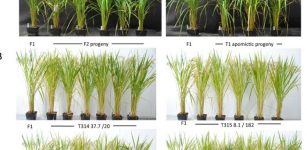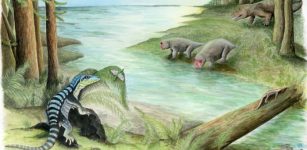Cambroraster: Voracious Cambrian Predator Uncovered In Canadian Rockies
Eddie Gonzales Jr. – MessageToEagle.com – Fossils of a large new predatory species have been uncovered in the Canadian Rockies and date back to the Cambrian Period.
This new species – named Cambroraster falcatus – has rake-like claws and a pineapple-slice-shaped mouth at the front of an enormous head, and it sheds light on the diversity of the earliest relatives of insects, crabs, spiders, and their kin.
 This new species has rake-like claws and a pineapple-slice-shaped mouth at the front of an enormous head. Image Credit: Lars Fields © Royal Ontario Museum
This new species has rake-like claws and a pineapple-slice-shaped mouth at the front of an enormous head. Image Credit: Lars Fields © Royal Ontario Museum
In a new study, paleontologists at the Royal Ontario Museum and University of Toronto say this creature is up to a foot in length, and comes from the famous 506-million-year-old Burgess Shale.
“Its size would have been even more impressive at the time it was alive, as most animals living during the Cambrian Period were smaller than your little finger,” said Joe Moysiuk, a graduate student based at the Royal Ontario Museum who led the study, said in a press release.
Cambroraster was a distant cousin of the iconic Anomalocaris, the top predator living in the seas at that time, but it seems to have been feeding in a radically different way,” Moysiuk explained.
The name Cambroraster refers to the remarkable claws of this animal, which bear a parallel series of outgrowths, looking like forward-directed rakes.
“We think Cambroraster may have used these claws to sift through sediment, trapping buried prey in the net-like array of hooked spines,” added Dr. Jean-Bernard Caron, the leader of the expeditions that found the fossils.
Perhaps even more astonishing is the large number of specimens recovered.
The fossils were found at several sites in the Marble Canyon area in Kootenay National Park, British Columbia, about 40 kilometers away from the original Burgess Shale fossil site in Yoho National Park that was first discovered in 1909.
 Reconstruction, Image Credit: Lars Fields © Royal Ontario Museum
Reconstruction, Image Credit: Lars Fields © Royal Ontario Museum
“The sheer abundance of this animal is extraordinary,” added Dr. Caron.
“Over the past few summers we found hundreds of specimens, sometimes with dozens of individuals covering single rock slabs.”
Researchers were able to reconstruct Cambroraster in unprecedented detail, revealing characteristics that had not been seen before in related species.
“The radiodont fossil record is very sparse; typically, we only find scattered bits and pieces. The large number of parts and unusually complete fossils preserved at the same place are a real coup, as they help us to better understand what these animals looked like and how they lived,” said Dr. Caron.
“We are really excited about this discovery. Cambroraster clearly illustrates that predation was a big deal at that time with many kinds of surprising morphological adaptations.”
“Far from being primitive, radiodonts show us that at the very outset of complex ecosystems on Earth, early representatives of the arthropod lineage rapidly radiated to play a wide array of ecological roles,” remarked Moysiuk.
Written by Eddie Gonzales Jr. – MessageToEagle.com Staff










